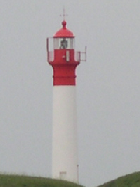

Menu:

Phare de l'île d'Aix
Calculs sur les vecteurs d'une base orthonormée directe:
- $ i↖{→}.i↖{→} = j↖{→}. j↖{→} =k↖{→}.k↖{→}=1$
- $ i↖{→}.j↖{→} = j↖{→}. k↖{→} =k↖{→}.i↖{→}=0$
32- Produit Vectoriel
$ \table E^2 → E ; ( X↖{→}, Y↖{→})→ X↖{→}∧ Y↖{→} = A↖{→} $Dans une base $( i↖{→}, j↖{→},k↖{→})$, si $ X↖{→}=x_1 .i↖{→} + x_2 . j↖{→} + x_3 .k↖{→}$ et $ Y↖{→}=y_1 .i↖{→} + y_2 . j↖{→} + y_3 .k↖{→} $ alors $X↖{→}∧ Y↖{→} =(x_2 .y_3-x_3 .y_2).i↖{→} + (x_3 .y_1-x_1 . y_3).j↖{→} + (x_1 .y_2-x_2 .y_1).k↖{→}$
Remarque :
Le résultat du produit vectoriel de deux vecteurs est un VECTEUR.
Méthode de calcul : Calcul à effectuer : $ |{\table x_1;x_2;x_3} ∧ |{\table y_1;y_2;y_3}$
Première composante: On barre la première ligne et on calcule le déterminant 2*2 restant :
$ |{\table x_1;x_2;x_3} ∧ |{\table y_1;y_2;y_3}$ $→$ $|{\table x_2, y_2;x_3,y_3}| =x_2 .y_3-x_3 .y_2$